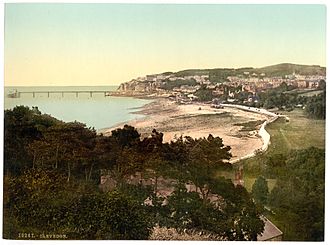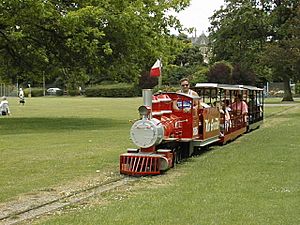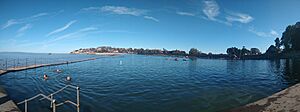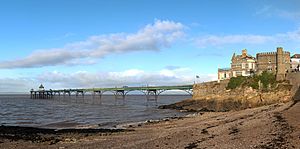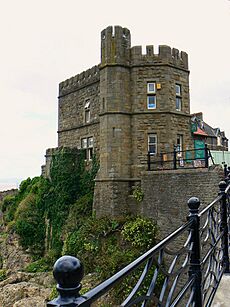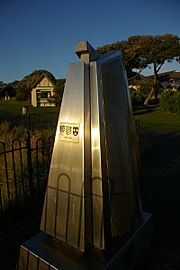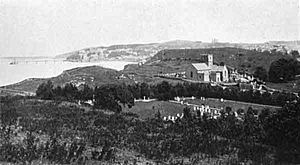Clevedon facts for kids
Quick facts for kids Clevedon |
|
|---|---|
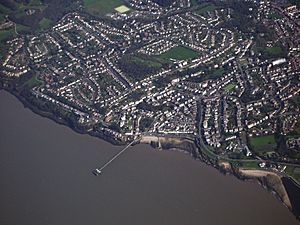 View of Clevedon from the air, showing the pier |
|
| Population | 22,000 |
| OS grid reference | ST406714 |
| Unitary authority | |
| Ceremonial county | |
| Region | |
| Country | England |
| Sovereign state | United Kingdom |
| Post town | CLEVEDON |
| Postcode district | BS21 |
| Dialling code | 01275 |
| Police | Avon and Somerset |
| Fire | Avon |
| Ambulance | Great Western |
| EU Parliament | South West England |
| UK Parliament |
|
Clevedon is a lovely seaside town located in North Somerset, England. It sits right along the Severn Estuary, which is a big river mouth. In 2019, about 21,442 people lived here.
Clevedon is surrounded by small hills like Church Hill and Wain's Hill. Wain's Hill even has the remains of an ancient Iron Age hill fort! The town was first mentioned way back in the year 1086 in the Domesday Book. It became a popular seaside resort during the Victorian era, which was a long time ago.
Contents
- Discovering Clevedon: Fun Things to See and Do
- Clevedon's Past: A Journey Through Time
- How Clevedon is Run: Local Government
- Clevedon's Landscape: Hills, Sea, and Views
- Clevedon's Businesses: What the Town Does
- Famous Places: Clevedon's Landmarks
- Learning in Clevedon: Schools and Education
- Places of Worship: Clevedon's Churches
- Getting Around: Railways in Clevedon
- Staying Active: Sports in Clevedon
- Media and Culture: Clevedon's Creative Side
- Famous People from Clevedon
- Images for kids
- See also
Discovering Clevedon: Fun Things to See and Do
Clevedon has a unique rocky beach. It's so special that it's been named a Site of Special Scientific Interest because of its geology.
Clevedon Pier: A Victorian Treasure
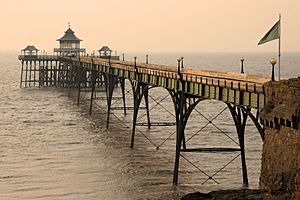
The famous Clevedon Pier first opened in 1869. It's one of the oldest Victorian piers still standing in the UK! Sadly, parts of it collapsed in 1970. But don't worry, it was beautifully restored and reopened in 1989. Today, you can enjoy walks along the pier and even take boat trips from it.
Clevedon's Past: A Journey Through Time
The name "Clevedon" comes from old English words meaning "cleft" or "hill." This makes sense, as the town is built among several hills.
Ancient Times: Iron Age Forts
Wain's Hill, just outside Clevedon, has an ancient Iron Age hill fort. This fort was protected by steep natural slopes and two walls built by people long ago.
From Farming Village to Seaside Town
In the year 1086, the Domesday Book described Clevedon as a small farming village. It had a few villagers and smallholders. Two small rivers, the Land Yeo and Middle Yeo, powered mills that were used for things like processing cloth.
During the Victorian era, Clevedon completely changed. People loved going to the seaside for bathing, so Clevedon grew into a popular resort town. They even had saltwater baths and special bathing machines on the beach!
A Home for Children: St Edith's
For nearly 100 years, Clevedon was home to St Edith's Children's Home. It was run by nuns and closed in 1974. The building is still there on Dial Hill, but it's now private apartments.
Clevedon's Railways: Connecting the Town
Clevedon used to have its own train line, which opened in 1847. It connected the town to Yatton. This line closed in 1966, and the old station site is now a shopping area called Queen's Square. There was also another railway, the Weston, Clevedon and Portishead Light Railway, which connected Clevedon to other coastal towns.
Penicillin: A Life-Saving Discovery
Did you know that the first large-scale production of penicillin happened in Clevedon? In the late 1930s, scientists at Oxford University read about how a special mould could fight bacteria. They arranged for this mould to be grown in large tanks at the Medical Research Council's station in Clevedon. This helped create a lot of penicillin, which was used to treat infections in soldiers during World War II.
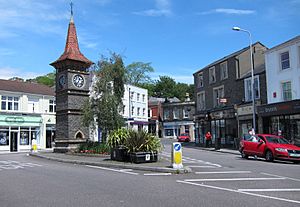
How Clevedon is Run: Local Government
Clevedon is part of the North Somerset area. The town has a local council that helps manage things like parks, community events, and local services. The town hall, where the council meets, was built in 1860 and used to be a school.
Clevedon's Landscape: Hills, Sea, and Views
Clevedon is famous for its seven hills, including Church Hill and Dial Hill. From these hills, you can see amazing views across the Severn Estuary all the way to Wales on a clear day! You might even spot the islands of Steep Holm and Flat Holm in the Bristol Channel. The tide here is very strong, rising and falling a lot, second only to the Bay of Fundy in Canada.
Fun by the Sea: Marine Lake and Salthouse Field
The seafront stretches for about half a mile, from the pier to Salthouse Field. Here you'll find pretty gardens, a Victorian bandstand, and places to play tennis or crazy golf.
The Marine Lake used to be a Victorian swimming pool. Now, it's used for boating and hosts a small festival where people can try new water sports. Salthouse Field has a fun light railway that goes around its edge, and in summer, you can even enjoy donkey rides!
Poets' Walk: Nature and Inspiration
"Poets' Walk" is a lovely footpath that goes around Wain's Hill and Church Hill. It's named after famous poets like Samuel Taylor Coleridge and Alfred, Lord Tennyson who visited Clevedon. This area is a local nature reserve with beautiful grasslands, coastal plants, and woodlands.
Clevedon's Weather: A Mild Climate
Clevedon has a mild climate, meaning it's generally not too hot or too cold. It's often a bit wetter than other parts of the UK, but the sea helps keep temperatures steady. The warmest months are July and August, and the coldest are December and January.
Clevedon's Businesses: What the Town Does
Clevedon has some light industries, mostly on business parks near the M5 motorway. Many people also live in Clevedon and travel to work in Bristol.
One interesting local business is Percy Daniel & Co, which builds and repairs organs for churches. Yeates Removals, a moving company, started in Clevedon in 1910 using horses and carts! It's still run by the same family today.
Famous Places: Clevedon's Landmarks
Clevedon Court: A Historic Home
Clevedon Court is a very old house on Court Hill. It's one of the few 14th-century manor halls left in England, built around 1320. For centuries, it's been owned by the Elton family, who also helped improve the town. The house is now looked after by the National Trust.
Walton Castle: A Hunting Lodge
Walton Castle is a 17th-century fort on Castle Hill. It was built around 1615-1620 as a hunting lodge. For a long time, it was just a ruin, but it was bought for £1 in 1978 and beautifully restored!
Royal Pier Hotel: From Hotel to Homes
The Royal Pier Hotel is a grand old building next to the pier. It was built in 1823. After closing in 2001, it became run down, but it has since been turned into fancy apartments.
Clevedon Pier: A Restored Beauty
As mentioned, Clevedon Pier is a true landmark. After its collapse in 1970, it was carefully taken apart, restored, and rebuilt. It's now a Grade I listed building, meaning it's very important historically. You can take trips on paddle steamers like the Waverley from the pier. Next to the pier is the Toll House, which looks like a small castle and used to house the pier-master.
Other Notable Landmarks
- The Clevedon clock tower in the town centre was built in 1898. It was a gift from Sir Edmund Elton to celebrate Queen Victoria's Diamond Jubilee.
- The Curzon cinema opened in 1912. It's one of the oldest cinemas in the world that's still showing movies!
- The Clevedon Marine Lake was restored in 2015 and is now a popular spot for water activities.
- The "Spirit of Clevedon" is a special monument near the seafront. It was put up in 2000 to mark the Millennium and has panels showing the town's history. It even has a time capsule inside!
Learning in Clevedon: Schools and Education
Clevedon has a secondary school called Clevedon School, which has about 1,200 students. It's a comprehensive school, meaning it teaches a wide range of subjects.
There are also several primary schools in Clevedon, including:
- Mary Elton Primary School
- St John the Evangelist Primary School
- All Saints C of E Primary School
- St Nicholas's Chantry CEVC Primary School
- Yeo Moor Primary School
Mary Elton Primary School is named after Mary Elton, who helped set up local schools in the 1800s. Famous footballer Jack Butland attended Yeo Moor School and Clevedon School.
Places of Worship: Clevedon's Churches
Clevedon has several churches. St. Andrew's church was built in the 13th century, but it might have even older foundations from Saxon times. It's the burial place of Arthur Hallam, who was a friend of the famous poet Alfred, Lord Tennyson.
Other churches include:
- The Church of St John, built in 1876–1878.
- The Church of All Saints, built in 1861.
- Christ Church, whose tower is a well-known landmark.
- The Roman Catholic Church of the Immaculate Conception.
Getting Around: Railways in Clevedon
Even though Clevedon's own train line closed in 1966, the closest railway station is still at Yatton. You can catch trains there to other places.
Staying Active: Sports in Clevedon
Clevedon's location by the sea makes it great for water sports!
- Clevedon Canoe Club offers sea paddling trips.
- Clevedon Sailing Club is also nearby.
Team Sports
- Clevedon Cricket Club, founded in 1874, plays in a top league.
- Clevedon Town Football Club is a long-standing team that plays at the Everyone Active Stadium.
- Another football club, Clevedon United F.C., plays at Coleridge Vale.
- Swiss Valley Rangers FC is a junior football club for younger players.
- Clevedon Bowling Club, formed in 1910, has won many international awards.
Other Sports
You can also find Clevedon Golf Club, a Riding Centre, and a Rugby Club in the town.
Media and Culture: Clevedon's Creative Side
Local News and Entertainment
You can get local news and TV from BBC West and ITV West Country. Clevedon also has its own community radio station, Radio Clevedon, and a local newspaper, North Somerset Times.
Writers and Films
Many writers have been inspired by Clevedon:
- Samuel Taylor Coleridge lived here for a while.
- William Makepeace Thackeray often visited Clevedon Court.
- The writer George Gissing set one of his novels, The Odd Women, in Clevedon.
Clevedon has also been a filming location for movies and TV shows:
- The final scene of the 1993 movie The Remains of the Day was filmed here.
- Scenes from the TV movie Cider with Rosie (1998) were shot in Clevedon.
- The 2010 film Never Let Me Go also filmed scenes in the town.
- Clevedon even has its own comic book superhero, Captain Clevedon!
Twin Towns
Clevedon is "twinned" with several towns in other countries, meaning they have special friendly connections:
- Ettlingen, Germany (since 1980)
- Épernay, France (since 1990)
- Middelkerke, Belgium (since 1991)
Broadchurch: A TV Drama Setting
The popular detective drama Broadchurch, which first aired in 2013, used Clevedon (especially St Andrew's Church) as one of its main filming locations.
Famous People from Clevedon
Many interesting people have connections to Clevedon:
- Edward Tyson (1651–1708), a pioneer in science.
- Samuel Taylor Coleridge (1772–1834), a famous writer who spent his honeymoon here.
- Arthur Hallam (1811–1833), a poet buried in Clevedon, who was the subject of a famous poem by Alfred, Lord Tennyson.
- Sir Arthur Elton, 7th Baronet (1818–1884), a local politician who helped the town.
- Edward Raymond Turner (1873–1903), an inventor of early colour cinema.
- Jan Morris (1926–2020), a famous author and travel writer who reported on the first climb of Mount Everest.
- David Bryant (1931–2020), a three-time world champion in bowls.
- Bob Anderson (born 1947), a world professional darts champion.
- Brady Haran (born 1976), a popular YouTube video producer who lives in the town.
- Tuppence Middleton (born 1987), a film and TV actress who grew up in Clevedon.
- Luke Spiller (born 1988), the lead singer of the band The Struts, grew up here.
- Jack Butland (born 1993), an England international football goalkeeper.
Images for kids
See also
 In Spanish: Clevedon para niños
In Spanish: Clevedon para niños



